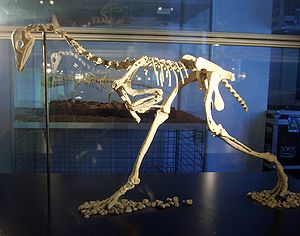- Patagopteryx
-
Patagopteryx 
Patagopteryx, Skelettrekonstruktion
Zeitraum Santonium (Oberkreide) 85,8 bis 83,5 Mio. Jahre Fundorte Systematik Pygostylia Ornithothoraces Ornithuromorpha Patagopterygiformes Patagopterygidae Patagopteryx Wissenschaftlicher Name Patagopterygiformes Alvarenga & Bonaparte, 1992 Wissenschaftlicher Name Patagopterygidae Alvarenga & Bonaparte, 1992 Wissenschaftlicher Name Patagopteryx Alvarenga & Bonaparte, 1992 Patagopteryx ist eine ausgestorbene Gattung flugunfähiger Vögel der oberen Kreidezeit. Die fossilen Überreste von insgesamt drei Exemplaren wurden in der Bajo de la Carpa Formation im nordwestlichen Patagonien (Neuquén) gefunden. Einzige Art ist Patagopteryx deferrariisi.
Inhaltsverzeichnis
Merkmale
Patagopteryx war etwa hühnergroß, hatte starke Hinterbeine und zurückgebildete Flügel. Der Fuß ist pamprodactyl, alle vier Zehen zeigen nach vorn. Die Phalanagenformel ist 2-3-4-5.
Das Skelett lässt vermuten, dass seine Vorfahren flugfähig waren. Das Brustbein ist klein und hat keinen Brustbeinkamm (Carina sterni). Auch der Carpometacarpus, ein Knochen, der aus der Verwachsung der distalen Handwurzelknochen (Ossa carpalia distalia) miteinander und mit den proximalen Enden der ursprünglich drei Mittelhandknochen (Ossa metacarpalia) entstanden ist, ist klein. Patagopteryx ist damit der älteste Vogel, für den eine sekundäre Flugunfähigkeit nachzuweisen ist.
Seine Rumpfwirbel waren vom primitiven procoelen (vorn konkav, hinten konvex) Typ, alle anderen Wirbel waren heterocoel (beide Enden konkav), wie es für moderne Vögel typisch ist. Ischium und Pubis zeigen beide nach hinten. Die langgestreckten Knochen der Art zeigen deutliche Wachstumsringe, was auch für die Enantiornithes typisch ist, aber sonst bei keiner weiteren kreidezeitlichen oder modernen Vogelgruppe auftritt. Eventuell differierte er physiologisch von den modernen Vögeln, war nicht vollständig endotherm und musste einen Teil des Jahres in einer Art Kältestarre verbringen. Er lebte in einem kontinentalen Klima, das sich durch jahreszeitlich bedingte große Temperaturschwankungen auszeichnete.
Systematik
Patagopteryx wurde ursprünglich für einen primitiven Angehörigen der Laufvögel gehalten. Heute gilt seine Position innerhalb der Vogelsystematik als isoliert und er steht in einer eigenen Familie und Ordnung. Die wahrscheinliche systematische Stellung zeigt folgendes Kladogramm:
Vögel (Aves) Pygostylia Ornithothoraces Ornithuromorpha Patagopteryx
Ornithurae Carinatae Neornithes (rezente Vögel)
Literatur
- Alan Feduccia: The Origin and Evolution of the Birds. 2. Aufl., Yale University Press, New Haven/ London, 1999, ISBN 0300078617
- Luis M. Chiappe, Lawrence M. Witmer: Mesozoic birds: above the heads of dinosaurs. bei Google Books
- Michael J. Benton: Paläontologie der Wirbeltiere. 2007, ISBN 3899370724
Weblinks
- DinoData Patagopteryx deferrariisi
Wikimedia Foundation.
